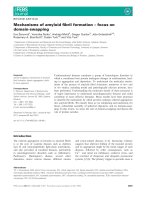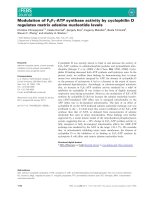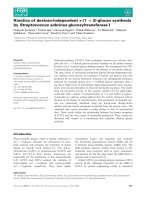Tài liệu Báo cáo khoa học: "Integration of Large-Scale Linguistic Resources in a Natural Language Understanding System" pdf
Bạn đang xem bản rút gọn của tài liệu. Xem và tải ngay bản đầy đủ của tài liệu tại đây (348.04 KB, 5 trang )
Integration of Large-Scale Linguistic Resources in a Natural
Language Understanding System
Lewis M. Norton, Deborah A. Dahl, Li Li, and Katharine P. Beals
Unisys Corporation
2476 Swedesford Road
Malvern, PA USA 19355
{ norton,dahl,lli.beals } @tr.unisys.com
Abstract
Knowledge acquisition is a serious bottleneck
for natural language understanding systems.
For this reason, large-scale linguistic resources
have been compiled and made available by
organizations such as the Linguistic Data
Consortium (Comlex) and Princeton University
(WordNet). Systems making use of these
resources can greatly accelerate the
development process by avoiding the need for
the developer to re-create this information.
In this paper we describe how we integrated
these large scale linguistic resources into our
natural language understanding system. Client-
server architecture was used to make a large
volume of lexical information and a large
knowledge base available to the system at
development and/or run time. We discuss
issues of achieving compatibility between these
disparate resources.
1 NL Engine
Natural language processing in the Unisys natural
language understanding (NLU) system (Dahl,
Norton and Scholz (1998), Dahl (1992)) is done by
a natural language (NL) engine with the
architecture shown in Figure 1. Processing stages
include lexicai lookup, syntactic parsing, semantic
analysis, and pragmatic analysis. Each stage has
been designed to use linguistic data such as the
lexicon and grammar, which are maintained
separately from the engine, and can easily be
adapted to specific applications.
2 Linguistic ~;ervers
The template NL Engine, on which all NL Engine
applications are based, contains lexical information
for about 3000 English words. This includes
information on an exhaustive set of closed-class
words prepositions, pronouns, conjunctions, etc.
It also includes information for a few hundred of the
most frequently-used words in each of the open-
class word classes, the nouns, verbs, adjectives and
adverbs. An NL Toolkit enables a developer to
enter such information for additional words
manually. Since the core vocabulary of 3000
words is insufficient for any real application,
manual development could be a substantial task.
Our linguistic servers are provided to greatly reduce
the magnitude of that task. The servers contain the
necessary information for many more words than
the base system. This information can be extracted
at development time, modified if appropriate (for
instance, an application may not need all senses of a
word), and included in the NL Engine application.
The linguistic servers may or may not be present at
run time of a fully-developed application (at the
deployer's choice).
When information about a word is needed during
processing, the available lexical resources are
accessed in the following order:
1. application-specific vocabulary supplied by the
developer (either manually or by extraction
from the linguistic servers).
2. the core 3000-word vocabulary.
3. the linguistic servers, if present.
980
4. Finally, if the required information is not found
in any of the linguistic resources, there are
default assumptions for all linguistic
information, to be described later.
There are four linguistic servers, corresponding to
the four major categories of lexical information
used in our system: lexicon, knowledge base,
denotations, and semantics.
2.1 Lexicon Server
The lexicon server is based on Comlex, a machine-
readable dictionary which was developed at New
York University and distributed by the Linguistic
Data Consortium (Grishman, Macleod and Wolf
(1993)). Comlex contains detailed syntactic
information for about 45,000 English words,
including part of speech, morphological variations,
lexical features, and subcategorizations.
Relatively little effort was needed to convert
Comlex into a form usable by our system. A
simple PERL program performed a conversion
from the LISP syntax used for Comlex into Prolog,
the language used for our system. Second, the
features and subcategorizations represented in
Comlex are encoded in terms of grammatical
concepts first developed at NYU in the 1970's by
Naomi Sager (Sager (1981)). The Unisys NLU
system's syntactic component is based on Sager's
work. As a result, little more than some name
substitution was necessary to make the Comlex
information usable by our system.
2.2 Knowledge Base Server
The knowledge base server is based on WordNet, a
machine-readable hierarchical network of concepts
which was developed and distributed by Princeton
University (Miller (1990)), and on work done at the
Information Sciences Institute (ISI) of the
University of Southern California. Concepts in
WordNet do not have names they are just sets of
words (calledsynsets). ISI has supplied mnemonic
names for the WordNet synsets and made them
generally available to the WordNet community.
(Examples of some of the ISI concept names can be
seen in Figure 2.) The WordNet concepts
correspond to real-world entities and phenomena in
terms of which people understand the meanings of
words. Our knowledge base server is currently
concerned with only the concepts corresponding to
nouns, because our system makes little use of
hierarchical information about other parts of
speech.' There are about 60,000 of these noun
concepts in WordNet, including ancestor concepts
which provide a taxonomy to the concept set.
Conversion of the WordNet KB was also
straightforward. WordNet files in Prolog are part
of the standard WordNet distribution. Therefore,
the bulk of the task involved routine reformatting
into the primitives of the Unisys NLU system. Our
system already made use of a semantic network
knowledge representation system known as M-
PACK, a KL-ONE (Brachman and Schmolze
(1985)) derivative which supports multiple
inheritance. Our core system has a small M-PACK
knowledge base, which we wanted to retain both to
preserve compatibility with old applications and
because it contained useful concepts which were not
present in WordNet. To merge the two KBs, all
we needed to do was to make each of the 11 unique
beginners for WordNet noun hierarchies immediate
children of appropriate concepts in our knowledge
base. Making use of multiple inheritance, we also
provided is-a links between selected WordNet
synsets and the appropriate concepts in our small
KB. For example, while our original KB contained
a concept city_C, WordNet has two disjoint
subtrees of cities (roughly corresponding to cities
which are administrative centers such as capitals,
and those which are not). By making both of these
subtrees children of city_C we achieved the needed
generalization, as shown in Figure 2.
2.3 Denotations Server
The denotations server, also based on WordNet and
the ISI name list, provides the links between words
and KB concepts, thereby integrating Comlex and
WordNet. Because many nouns have multiple
senses, the denotations server has over 100,000
such links for English nouns. A word is said to
denote one or more concepts, according to these
' Our knowledge base server does contain aspect
information for verb senses; this information was
compiled at Unisys, not from WordNet.
981
links. Figure 3 illustrates this many-to-many
relationship. In WordNet the senses of a word are
ordered by their frequency of use in English, and
our denotations server preserves this ordering. The
denotations server supplies information to the NL
Engine enabling it to extract from the knowledge
base server the concepts denoted by the words
extracted from the lexicon server. Also extracted
are the ancestor concepts for the denoted concepts.
Thus, for example, the NL Engine "knows" after
extraction that Boston and Philadelphia are both
cities.
2.4 Semantics Server
The semantics server, based on data compiled by
our group at Unisys, supplies information about the
semantic structure of concepts associated with
English words, particularly verbs. For example, the
verb
abridge
has an associated case frame
consisting of an agent doing the abridging and an
optional theme that is being abridged. Furthermore,
in an English sentence using the
verbabridge,
the
agent is typically found in the subject and the theme
in the object. Words other than verbs can have
similar information. The semantics server contains
such information for about 4300 words, mostly
verbs; the verbs account for over 60% of the verbs
in Comlex.
There needs to be consistency between the
information in the lexicon and semantics servers.
For example, every verb which is declared to be
ditransitive in Comlex should have a semantic rule
mapping both the object and indirect object to
distinct roles such as theme and goal. We
developed a semi-automatic tool which examined
every verb which had rules in the semantics server,
and based on the lexical entry for that verb, added
additional semantic rules to account for all of the
verb's subcategorizations, or object options. These
automatically fabricated rules were not always
correct (the
prepositionagainst
does not always
imply an opposing force, for instance), but they
were a good start. The most difficult manual task
in reviewing these rules had to do with the issue of
verb senses. Because verb senses are not separated
in Comlex entries, the tool assumed that all the
lexical subcategorizations of a verb applied to a
single verb sense. When this was not the case, the
semantic rules had to be divided into subsets for
each individual sense, a process that we could not
do automatically.
3 Default Linguistic Information
If information about a word is not found in any of
our linguistic resources, the NL Engine can guess
the required information. An unknown word will be
assumed to be a proper noun, denoting a
dynamically-created concept in the application's
knowledge base, inserted as a child of our top-level
concept "thing". A verb with no semantic
information will be assigned roles such as agent or
theme based on the syntax of the input utterance
and statistical information about usage of these
roles generally in other English verbs (Dahl
(1993)). The default guesses are frequently
sufficient for the NL Engine to make a usable
interpretation of an input utterance containing an
unknown word.
4 LAN Operation
Each linguistic server can be used to respond to
multiple developers, or to multiple instances of a
run-time NLU application. The servers can be run
on separate processors (running under either
Windows NT or UNIX), connected by a LAN.
This minimizes the cost of utilizing the servers,
which although they are relative large processes,
can support many clients efficiently.
5 Evaluation
We analyzed a small corpus of 1330 sentences (on
the subject of our NLU system) in order to give a
quantitative description of the contribution of our
lexicon and semantics servers. Our corpus
contained forms of 526 distinct roots. Over 60% of
these roots had definitions in our core vocabulary.
Definitions for an additional 25% were extracted
from the lexicon server. Analysis of the remaining
71 roots showed that a developer would have
needed to enter definitions for 20 common nouns, 2
verbs, and 2 adjectives; the rest were truly proper
nouns as assigned by default. The 24 roots not
982
covered were for the most part instances of
technical jargon for our domain?
For the 215 verbs in our corpus, again over 60%
had semantic rules in our core NL Engine. Our
semantics server contributed rules for an additional
38%, leaving our developer with the need to write
rules (or rely on guessed default rules) for only 2
verbs. These results are summarized in Table 1.
Thus, in this application the servers would have
enabled the developer to avoid creating 132 lexical
entries and 82 semantic rules. In addition, the
default mechanism would have eliminated the need
for manual entry of 47 more lexical entries.
in core
in server
not present
total
Lexicon
Server
323 (61.5%)
132 (25%)
71 (14.5%)
526 (100%)
Semantics
Server
131 (61%)
82 (38%)
2(1%)
215 (100%)
Table 1
Conclusion
We have successfully integrated diverse large-scale
linguistic resources, both externally and internally
compiled, using a client-server architecture, for use
with a general-purpose natural language
understanding system. The conversion of resources
such as Comlex and WordNet into a format usable
by our system was straightforward, and the
resulting complex of resources executes without
any performance problems in a multi-user
environment. The task of a developer of a
particular natural language application is greatly
simplified by the presence of these resources.
In the future we plan to incorporate WordNet
information for verbs into our KB server, and to
add semantics rules for the remaining Comlex verbs
into the semantics server. We also expect to
augment the semantics server with semantic class
constraints on the fillers of roles such as agent, and
to create a fifth server, containing selection
constraints.
References
Brachman R. J. and Schmolze I. G. (1985) An
overview of the KL-ONE knowledge representation
system. Cognitive Science 9/2, pp. 171-216.
DaM D.A. (1992) .Pundit natural language
interfaces. In "Logic Programming in Action", G.
Comyn, N.E. Fuchs, and M.J. Ratcliffe, eds.,
Springer-Verlag, Heidelberg, Germany, pp. 176-185.
Dahl D.A. (1993) Hypothesizing case frame
information for new verbs. In "Principles and
Prediction: The Analysis of Natural Language", M.
Eid and G. Iverson, eds., John Benjamin Publishing
Co., Philadelphia, Pennsylvania, pp. 175-186.
Dahl D.A., Norton L.M. and Scholz, K.W. (1998).
Commercialization of Natural Language Processing
Technology. Communications of the ACM, in press.
Grishman R., Macleod C. and Wolf S. (1993) The
Comlex syntax project. Proceedings of the ARPA
Human Language Technology Workshop, Morgan
Kaufman, pp. 300-302.
Miller G. (1990) Five Papers on WordNet.
International Journal of Lexicography.
Sager N. (1981) Natural Language Information
Processing. Addison-Wesley, Reading,
Massachusetts, 399 p.
word conc~t word
gunpoint C ~_
muzzle<mouth C ~'~ muzzle
2 It is somewhat ironic that the words database and
parser are not in Comlex!
Figure 3. The denotes relation is many-to-many
983
ringuistic servers
r
lexical
processing
natural language processing
f
l
semantic ~
represenCa ih~n
final
-'semantics
I 1 processingmod ales
data supplied to
processing modules
Figure 1. Overall System Architecture
I I- lo~,tion_property_C ~ ~ ~ ~ ~
f ~ -~"-~ ~ ~ - ~ " ~, city_C '~ \
/ location~region C ~
TM
\ \
/ district~regi°n>_ / thland C \ \ \ \\\ ~~~ \" \\!
territorial~ / geographic_area C \ \ Ph,ladelphm_C ,
\ \ /
I seat[city C municipalily~a__C \ \
\
I
I capital<seat__.C
' I
\ \ state-lapital C
\ Boston C
urban_center C \
I
\'
I
Miami__(?
/
/
WordNet.bas ed
KB
Figure 2. Integration of KB Server data with core KB
(WordNet-based KB concept names from ISI see text)
984









